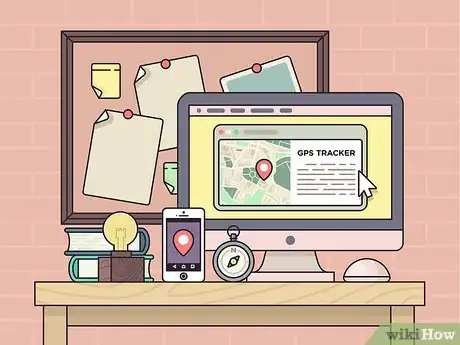This article was co-authored by Anna Colibri. Anna Colibri is a Digital Marketing Specialist and the CEO of Colibri Digital Marketing in the San Francisco Bay Area. Anna specializes in branding, digital strategy, product and service development, team management, and leadership development with a focus on women and minority business owners and professionals. Anna holds a Bachelor's degree in Sociology from The University of California, Davis, and a Master's degree in Social Welfare from The University of California, Berkeley. Colibri Digital Marketing is San Francisco’s first B Corp certified digital marketing agency. They won the 2019 Better Business Bureau Torch Awards for Ethical Business, the 2009 Local Excellence Award, and one of the Best Digital Marketing Agencies in San Francisco in 2017.
This article has been viewed 23,568 times.
The rideshare market has exploded in recent years and you may be wondering what it takes to get in on it. Despite the fact that there are some big names that dominate the market, there is still room for more, provided that you come up with a good business idea to set your company apart from the rest. After you have a solid idea, then you need to design your rideshare service carefully and make sure to comply with all legal requirements in your area. With some careful planning and hard work, starting your own rideshare business isn't out of reach!
Steps
Developing Your Business Idea
-
1Research and test other rideshare services to help you develop yours. Try any rideshare services that are available in your area and take notes on each competitor. Determine what their market is (what type of customer they target and areas they serve), what sets them apart from other services, and what advantages they have. It's very important to understand what the competitive landscape looks like and what you can expect out of the industry.
- For example, take notes on all the features your competitors' apps have to help you determine what features are absolutely necessary and what you can do better or add when you are developing your own app.
- Look at things like different kinds of cars available, areas targeted, or extra services to help you decide what will make your service different and special.
- Talk to people you know who use different rideshare services and ask them what they like and don't like about each service they have used to help you shape yours.
Tip: Ask drivers you ride with what they like and don't like about the rideshare companies that they work as drivers for. This can help you make your service more appealing to drivers as well as customers.
-
2Choose a niche for your business to differentiate it from competitors. You won't succeed if you try to make a rideshare app exactly like the big names out there, such as Uber and Lyft. Use your market research to help you choose a niche for your company that will differentiate you from the big, established competitors.[1]
- For example, you could focus your rideshare service on a certain market of riders, such as the elderly, students, or only people going to and from the airport or traveling around a certain part of town.
- Another way you could differentiate your business is to offer a certain type of car or comfort level. For example, you could offer only very eco-friendly cars, luxury cars, or oversized cars that can hold a lot of people.
Advertisement -
3Come up with a unique and catchy business name. Decide on several easy-to-remember names for your company that reflect that it is a rideshare business. Check that there are no apps, websites, or companies already out there that have the same name, or a similar one, so that people don't get confused.[2]
- It's a good idea to do a quick domain name check to see if there is a website domain available for the name you want to use.
- Some examples of rideshare names that are out there are Via, Wingz, Juno, Safr, HopSkipDrive, Summon, Arro, and Fasten. Those are just a few, but as you can see, there is quite a variety in names. In general, something short, simple, and related to the services you offer is a good choice.
-
4Determine your fare rates and percentage to monetize the service. The big rideshare apps take 20-25% of the fare of each ride and the driver gets the rest. For your own business, you could have flat rates based on distance or rates that go up like a taxi meter depending on the distance and time of the ride.[3]
- Flat rates might be best if your service only offers rides in a particular area or to and from a common destination like the airport. Metered rates could be better if you are covering a large area, such as an entire city.
- Taxi rates vary greatly from area to area. To help determine your own rates, you can look at the prices of other rideshare businesses and regular taxis in your area.
- Offering cheaper fares and taking a smaller cut of the fares from your drivers can help incentivize both drivers and riders to use your app, but it can be harder to make a profit. It can also make customers question the quality of your service if it seems too cheap.
- You can survey other rideshare drivers and ask how many riders they get on average in your area. Use this data to help you determine how high your rates and percentage need to be in order to turn a profit, as well as keep riders and drivers happy.
-
5Figure out if you can fund the business yourself or if you need investors. You will probably have to spend anywhere from $10,000-$70,000 USD to develop the app alone. You will also have to pay for marketing and advertising costs after you develop the app, purchase commercial insurance for each driver once you get up and running, and pay all of your employees.[4]
- Uber was started with $200,000 USD of capital, so you can use this as a rough guideline for how much money you may need up front out of your own pocket or from investors.
- An app developer's hourly fee can be from $30-$50 USD, professional marketing can cost you from $1000-$20,000 a month, and commercial insurance can cost about $750-$1200 USD yearly per driver.
-
1Develop an app with the basic necessary features that the service needs. The basic features any rideshare app needs are built-in GPS, a ride search function, some kind of ID verification, an emergency call button, a driver and rider chat and call system, a payment system, and a rating system. These features will pair riders with drivers, track routes, and help ensure that the drivers and riders are both safe.
- If you have experience with app development, you may be able to at least partly develop the app yourself. If not, you will need to find a developer or a company that specializes in app development to develop it for you.
- Decide how users will be allowed to sign up. For example, if they will be able to sign up with social media accounts, email, or just an ID.
-
2Add extra features to the app that incentivize riders to use it. Think about your niche and determine what other features you can add to the app to make it different from the competition. Things like being able to select different types of rides, choose preferred drivers, create carpool groups, or schedule rides in advance are all features to consider.[5]
- For example, if your rideshare business is targeting a luxury market, riders could be allowed to choose their preferred model of car. If your rideshare is targeting the elderly, maybe they could be allowed to select a preferred driver that they feel most comfortable with.
- If you are targeting riders who are only going to the airport, then you definitely want to allow riders to schedule their cars in advance so that they can get there on time. If you are targeting people in a certain area of town, then you might want to create a carpool feature.
Tip: Another feature to consider is rider support. You may want to offer 24/7 phone, email, or chat support through the app to riders to deal with any customer service issues that arise.
-
3Create a driver training program to teach new drivers how your service works. All rideshare businesses need to have at least a basic driver education course. This is so that all drivers understand the expectations and how the app and business model work.[6]
- At the very least, this course will need to teach drivers how to use the app. It's up to you if you want to add extra material about how to interact with clients, standards for how their cars should look on the inside and outside, and anything else relevant to your business.
- This is also a legal requirement to get the necessary permits for a rideshare business in many areas.
- Also, determine what your screening process will be for hiring and accepting drivers into this training program so they can start using your app. You can look at the application processes for big rideshare companies, like Uber and Lyft, to get an idea of how it works.
- You need to screen all drivers to make sure they don't have a history of reckless driving or violent criminal behavior.
-
4Build a website to market your service to both drivers and riders. Get a developer to create a website to promote your brand. The website needs info for drivers about how to apply, and info for riders about how the service works. Include lots of links to download the app so people can get it easily.[7]
- Other things to include on your website are security information, a privacy policy, payment options, and customer support info.
- This website will also be where all of your marketing and advertising efforts lead potential drivers and riders to.
- A business website also needs an "About" page that includes the mission, vision, purpose, brand, promise, and brand values. You include a history of the organization as well.
-
5Contract professional marketing services to reach potential clients and drivers. You will need to do professional marketing and advertising campaigns to get the word out about your new service. Hire a professional marketer or agency to develop a strategy for you and carry out the marketing activities.[8]
- For instance, you will probably need to do some combination of social media marketing, paid Internet advertising, email marketing, and traditional advertising such as flyers or a street marketing campaign.
- An agency or professional marketer will be able to help you come up with the best strategy for your business and actually carry it out. However, if you have experience in the field, you can also do some of these activities yourself.
Meeting Legal Requirements
-
1Create a business entity like an LLC or corporation to become a legal business. This is the first step to forming any type of business. An LLC or corporation will provide liability protection as well as allow you to pay taxes, open business bank accounts, and do everything else that goes along with running a business.[9]
- You can work with a business lawyer to complete this process and make sure you cover all your bases.
-
2Research and apply for permits that are required in your area. The legal status of rideshare businesses varies depending on country, state or region, and even city. Research what the legal requirements are for rideshare businesses in your region.[10]
- For instance, in the USA, rideshare businesses are regulated in each state by the Public Utilities Commission (PUC). Rideshare businesses in the USA need to get a Transportation Networking Company (TNC) permit from their local PUC.
- Search government websites or call government offices to research what the requirements are. If Uber or another rideshare service is licensed in your area, you can also check where they are registered and what permits they have to be in your area.
-
3Establish how you will perform criminal background checks on drivers. Running background checks on drivers is a legal requirement and is also very important to keep everyone safe. There are many services that will run background checks for you for about $10-$20 USD per check.[11]
- In the USA, to get a Transportation Networking Company (TNC) permit, you must perform a national criminal background check on drivers as well as check the national sex offenders database.
- For added security, you can also perform fingerprint background checks on drivers.
- You can find reliable criminal background check services online by using a keyword like "criminal background check service for employers". This will pull up lists of legitimate services for employers.
-
4Get commercial insurance that covers death, injury, and property damage. Your drivers will already have mandatory vehicle and driver insurance. You will need to get fleet-wide commercial insurance that covers your company for liability in the case of any accidents.
- Insurance requirements are another part of rideshare businesses that can vary based on location. If you are based in the USA, then check your state's insurance requirements for TNCs.
Tip: Expect to pay a large amount of your revenue towards insurance costs for a rideshare business. Some rideshare companies spend 25% of their revenue on commercial insurance.
References
- ↑ https://therideshareguy.com/how-to-start-a-rideshare-company/
- ↑ https://www.nerdwallet.com/blog/loans/9-new-ride-share-apps/
- ↑ https://www.cleveroad.com/blog/see-how-to-start-a-rideshare-business-and-make-a-rideshare-app-from-scratch
- ↑ https://www.cleveroad.com/blog/estimation-checklist-how-much-does-it-cost-to-develop-an-app-like-uber
- ↑ https://www.cleveroad.com/blog/see-how-to-start-a-rideshare-business-and-make-a-rideshare-app-from-scratch
- ↑ https://therideshareguy.com/how-to-start-a-rideshare-company/
- ↑ https://www.cleveroad.com/blog/see-how-to-start-a-rideshare-business-and-make-a-rideshare-app-from-scratch
- ↑ https://www.forbes.com/sites/quora/2018/03/28/what-are-the-best-app-marketing-strategies/#3118a45afea0
- ↑ https://therideshareguy.com/how-to-start-a-rideshare-company/










































































